
The Cyperaceae are a family of graminoid (grass-like), monocotyledonous flowering plants known as sedges. The family is large, with some 5,500 known species described in about 90 genera, the largest being the "true sedges" genus Carex with over 2,000 species.

The Aizoaceae, or fig-marigold family, is a large family of dicotyledonous flowering plants containing 135 genera and about 1800 species. They are commonly known as ice plants or carpet weeds. They are often called vygies in South Africa and New Zealand. Highly succulent species that resemble stones are sometimes called mesembs.

The genus Huernia consists of perennial, stem succulents from Eastern and Southern Africa and Arabia, first described as a genus in 1810.

Epacris is a genus of about forty species of flowering plants in the family Ericaceae. It was formerly treated in a closely related but separate family Epacridaceae, but the various genera within Epacridaceae including Epacris have been revised in their relationships to each other and brought under the common umbrella of the Ericaceae. The genus Epacris is native to eastern and southeastern Australia, New Caledonia and New Zealand. The species are known as heaths or Australian heaths.
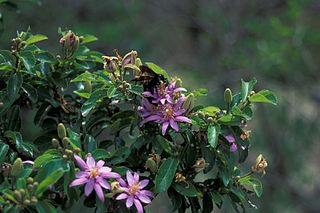
Grewia is a large flowering plant genus in the mallow family Malvaceae, in the expanded sense as proposed by the Angiosperm Phylogeny Group. Formerly, Grewia was placed in either the family Tiliaceae or the Sparrmanniaceae. However, these were both not monophyletic with respect to other Malvales - as already indicated by the uncertainties surrounding placement of Grewia and similar genera - and have thus been merged into the Malvaceae. Together with the bulk of the former Sparrmanniaceae, Grewia is in the subfamily Grewioideae and therein the tribe Grewieae, of which it is the type genus.

Lechenaultia is a genus of flowering plants in the family Goodeniaceae, the species native to Australia with one species also occurring in New Guinea. Plants in the genus Lechenaultia are glabrous shrubs or herbs with needle-shaped leaves, more or less sessile flowers with five sepals and five blue, white, or yellow and red petals in two unequal lobes, the fruit an elongated capsule.

Linnaea is a plant genus in the honeysuckle family Caprifoliaceae. Until 2013, the genus included a single species, Linnaea borealis. In 2013, on the basis of molecular phylogenetic evidence, the genus was expanded to include species formerly placed in Abelia, Diabelia, Dipelta, Kolkwitzia and Vesalea. However, this is rejected by the majority of subsequent scientific literature and flora.

Portulaca sedifolia is a species of flowering plant in the purslane family, Portulacaceae, that is endemic to Yemen. Its natural habitat is rocky areas.

Sprengelia is a genus of flowering plants in the family Ericaceae and is endemic to eastern Australia. Plants in the genus Sprengelia are slender, erect or low-lying shrubs with overlapping, stem-clasping leaves, many bracts at the base of the flowers, the sepals egg-shaped, white or coloured, the five petals with spreading lobes, and the fruit a capsule.

Geitonoplesium is a monotypic genus in the family Asphodelaceae, containing the sole species Geitonoplesium cymosum, commonly known as scrambling lily. The species is a perennial evergreen scrambling vine found in rainforests, sclerophyll forests and woodlands of eastern Australia, and parts of Malesia and Melanesia.
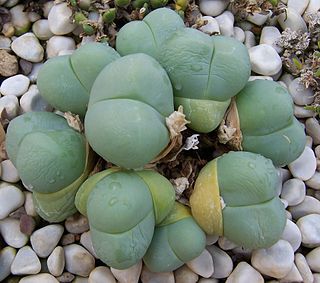
Gibbaeum is a genus of about 21 species of small succulent plants of the family Aizoaceae, indigenous to the Little Karoo region of South Africa. The name "Gibbaeum" comes from the Latin gibbosus (hunchback)
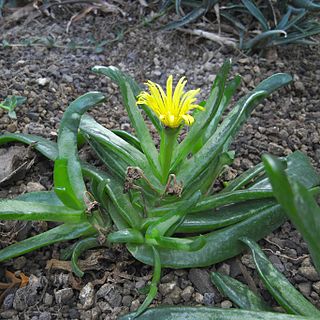
Glottiphyllum is a genus of about 57 species of succulent subtropical plants of the family Aizoaceae. It is closely related to the Gibbaeum and Faucaria genera. The name comes from ancient Greek γλωττίς glottis "tongue" and φύλλον phyllon "leaf". The species are native to South Africa, specifically to Cape Province and the Karoo desert. They grow in rocks and soils incorporating slate, sandstone and quartz. Rainfall in their native areas is between 125 and 500 mm, most of which falls in March and November.
Alistilus is a genus of flowering plants in the legume family, Fabaceae. It belongs to the subfamily Faboideae.

Tillandsia crocata is a species in the genus Tillandsia. This species is native to Brazil, Bolivia, Argentina, Paraguay and Uruguay.
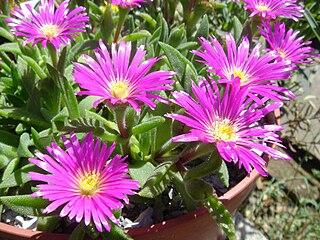
Delosperma sutherlandii is a dwarf perennial plant, native to South Africa. It forms a dense lawn with abundant, long-lasting flowering. It will reach sizes of 60 cm in diameter and approximately 10–15 cm tall, with possibly the largest flowers of its type.
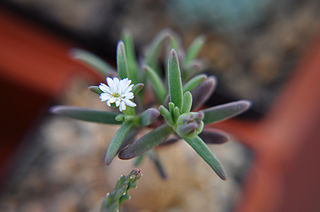
Delosperma napiforme is a dwarf perennial plant, native to the French Island of Réunion, but also now found in Madagascar. It has white flowers
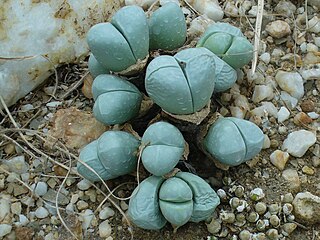
Oophytum is a genus of succulent plants native to South Africa. Both species are endemic to the Knersvlakte. Egg-shaped Oophytum plants develop two leaves opposite each other per season. At the end of winter the outer pair forms a sheath from which the new pair of leaves develop. Water cells are visible on the soft leaves giving them a shimmering appearance. The flowers, produced in winter, are white, pink, or a combination of both.

Thorncroftia is a genus of flowering plants in the mint family, Lamiaceae, first described as a genus in 1912. It is native to southern Africa.
- Thorncroftia greeniiChangwe & K.Balkwill - KwaZulu-Natal
- Thorncroftia longifloraN.E.Br - Mpumalanga, Eswatini
- Thorncroftia lotteriT.J.Edwards & McMurtry - Mpumalanga
- Thorncroftia mediaCodd - Northern Province of South Africa
- Thorncroftia succulenta(R.A.Dyer & E.A.Bruce) Codd - Northern Province of South Africa
- Thorncroftia thorncroftii(S.Moore) Codd - Mpumalanga, Eswatini, Northern Province of South Africa

Conophytum bilobum is a plant in the family Aizoaceae, native to southern South Africa. It blooms in autumn. It is scentless and grows to a height of 7 cm (2.8 in). The specific epithet bilobum comes from the two-lobed bodies these plants possess.

Gibbaeum dispar is a plant species in the family Aizoaceae, native to South Africa. It grows close to the ground and has short stems, causing it to grow in clumps.


















